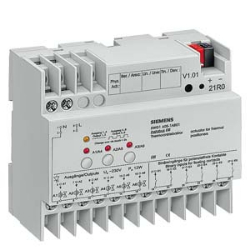Description
Thermal Drive Actuator. 6x Thermic Valves. 6x Binary Inputs
Product and Functional Description
The thermal drive actuator N 605 has been specially developed to control miniature valves with electrothermal valve drives for AC 230 V operating voltage. It is a DIN rail mounted component for the instabus EIB. All the cable connections are carried out via screw terminals except for the bus cable which is plugged in.
6 channels with semiconductor outputs are available to control the valve drives. The outputs each have 2 output terminals available (for N and switched L). A maximum of 4 thermal drives may be connected in parallel to one channel (actuator output). The outputs are monitored for short circuits and overload. If a short circuit or overload is detected, all the outputs are temporarily de-energized and the red LEDs are triggered to show a circulating light. After a cooling down period of 6 minutes, the individual outputs are switched on in sequence to determine where the short circuit or overload has occurred. It is reported via a special communication object which outputs are affected. These outputs are disabled for further operation and the associated red LEDs flash rapidly. All the other outputs are then operated as normal. It is only possible to reset a disabled channel by switching off the actuator from the mains voltage.
The application program enables the actuator outputs to be controlled via ON/OFF switching commands or via positioning commands expressed as a percentage. The latter are converted into switching commands with pulse width modulation under consideration of the heating up and cooling down periods of a thermal drive. A changed status or the current state of an output can be queried via a separate status object or sent automatically. The type of the output status object is always the same as the trigger object. The behaviour of the actuator on bus voltage failure can also be preselected (no action, switch on, switch off, forced position).
If the program function “Calcification protection†is activated, each actuator output is switched on and off once within a period of 6 days to prevent the valves from being fixed in position outside the heating respectively cooling period.
If you do not want that, in a room with several windows, the opening of only one window will switch the room thermostat to the building protection mode, hereby closing all heating and cooling valves, then the program function “Constrained Position†has to be activated. In this case, only the valve of the respective radiator or cooling ceiling element that is located in the immediate vicinity of the opened window is closed, except for a set residual opening (constrained position). If a logical connection of the “Constrained Position†object with the “Frost alarm†or “Outside temperature†object is selected and a frost alarm is not present or the outside temperature is > 1°C, the valve is fully closed if the “Constrained Position†object is identical to logical 1.
There are 6 additional binary inputs available for floating signal contacts in order to record and transmit the switching state e.g. of the window contacts or dew point detectors.
The power supply of the actuator electronics is carried out via an integrated power supply unit which is independent of the EIB bus voltage. Each output in a group of three outputs (outputs 1-3 or outputs 4-6) can be manually switched on or off or to the 50% open position via three push buttons which are integrated in the actuator and each have 1 red LED. The manual switching also functions if the bus cable is not connected or if the bus communication fails. After a long push button action (> 2 s), the other valve group is selected. The yellow LED indicates which of the two output groups can be operated (continuous light = outputs 1-3, flashing light = outputs 4-6).
Prerequisites
The user of the program must ensure that the following requirements are met for the error-free operation of the application program for the N 605:
- The user must specify via a parameter whether the room thermostat only sends switching command telegrams of type EIS 1 to activate a valve whereby a logical 0 corresponds to the command for closing the valve and a logical 1 corresponds to the command for opening the valve. Otherwise, it must be defined whether the valve is triggered via positioning commands of type EIS 6 expressed as percentage values whereby 0% corresponds to a closed valve and 100% to an opened valve.
- The room thermostat must ensure that it never sends switching or positioning commands which lead to the simultaneous opening of the heating and cooling valves (i.e. a switching/positioning command to open a valve may only be sent by the thermostat if it has previously sent a switching/positioning command to close the other valve).
- Thermal drives of the same type from the same manufacturer must be connected to all the outputs of the N 605. The user must indicate for each valve whether it is closed or opened in the de-energized state.
- If dew point detectors have been installed and are connected to the EIB, the room thermostat must send a “CLOSE†command (0% command) to the cooling supply valve if a dew point alarm is present followed by an “OPEN†command (100% command) when the dew point alarm is no longer present and further cooling is required.
- If the opening of a window is reported to the room thermostat via the EIB and the program function “Constrained Position†has not been activated, the thermostat must switch to “Building protection mode†and immediately send a “CLOSE†command (0% command) to the currently opened supply valve. In the “Building protection modeâ€, the room thermostat must ensure by controlling the valves that the room temperature does not fall below the setpoint value for frost protection respectively does not exceed the setpoint value for heat protection.
